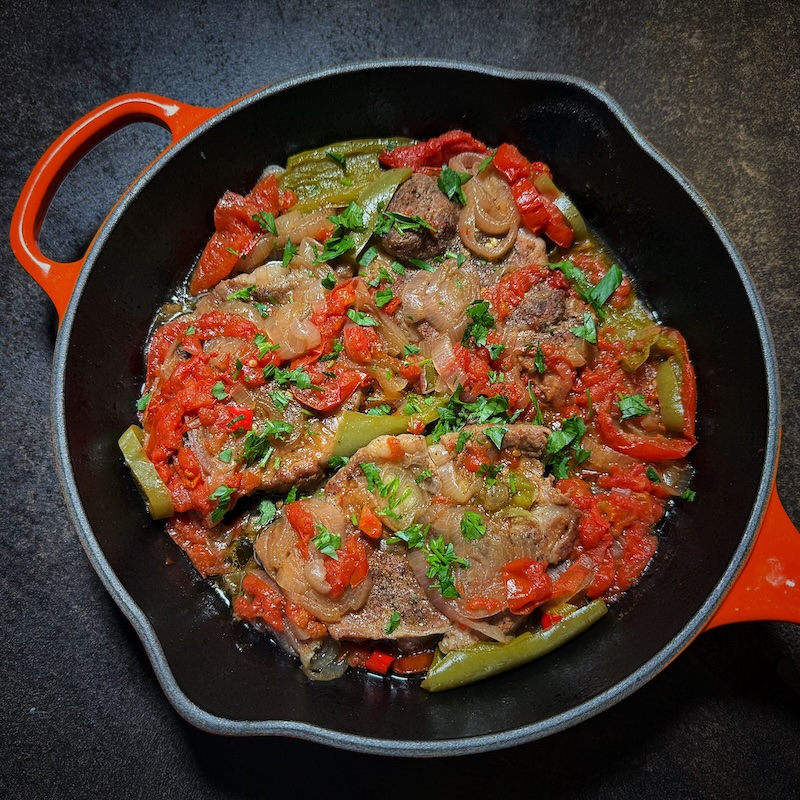Gochujang Turkey Stir-Fry: A Weeknight Treat
Quick and easy Gochujang Turkey Stir-Fry with fresh veggies and udon noodles. Ready in just 20 minutes, perfect for a flavorful weeknight dinner.
Servings
Prep Time
Cook Time
Ingredients
Total Time
Ingredients
- 200g turkey breast, cut into strips (or substitute with chicken)
- 1 large carrot, julienned
- 1/2 yellow bell pepper, sliced
- 1/2 red bell pepper, sliced
- 2 cloves garlic, minced
- 1 tbsp fresh ginger, minced
- 1 tbsp oil (vegetable or sesame)
- Basil leaves for garnish
- 200g udon noodles
- 1 tsp turmeric powder
- 1 tbsp gochujang paste
- 1 tbsp tomato paste
- 1 tbsp soy sauce
- 1 tsp fish sauce
- 1 tsp brown sugar
- 1 tbsp lime juice
- 80ml coconut milk
- 1 tbsp starch
Equipment
Instructions
Today, I want to share a recipe that's perfect for a weeknight dinner. It's super flavorful and can be made with turkey or chicken or even turned into a vegan version.
What's even better is that it's packed with umami, ready in just 20 minutes, and incredibly satisfying—perfect for dinner after a long day at work. So, without further ado, let's dive in and see what's in store!
Instructions:
- Make the Sauce: In a small bowl, mix together turmeric powder, gochujang paste, tomato paste, soy sauce, fish sauce, brown sugar, starch, and lime juice.
- Add the coconut milk and stir to combine.

- I like to start with the sauce because it allows the flavors to meld while I prepare the rest of the dish.
- Prepare the Turkey: Heat the oil in a large pan or wok over medium-high heat. Add the minced garlic and ginger, stir-frying for about 30 seconds until they release their aroma and become fragrant.
- Cook the Turkey: Add the turkey strips to the pan and stir-fry until they start to brown on all sides, about 3-4 minutes.

- Add the Vegetables: Toss in the julienned carrots and sliced bell peppers. Stir-fry for another 2-3 minutes until the vegetables are tender but still crisp.

- Combine with the Sauce: Pour the prepared sauce over the turkey and vegetables.

- Reduce the heat to low and let the sauce simmer for a minute until it thickens slightly.

- Cook the Noodles: Cook the udon noodles according to the package instructions. Once cooked, drain and add them to the pan with the sauce and turkey mixture.

- Mix Everything: Give everything a good mix to ensure the noodles are well-coated in the sauce.

- Serve: Garnish with fresh basil leaves and, if desired, sprinkle with chopped chilies for extra spice.

About This Dish: Flavor Influences and Nutritional Insights
This gochujang recipe is inspired by a mix of Korean and Southeast Asian flavors, focusing on balancing heat, sweetness, and creaminess.
I decided to use gochujang paste because it brings a rich depth of flavor, along with a gentle, lingering heat that pairs beautifully with the other ingredients.
Adding coconut milk softens the spicy notes, while lime juice adds brightness to the dish. Last but not least, turmeric gives this dish a lovely golden hue and earthy undertone, while fish sauce and soy sauce add umami depth.
Nutritionally, this meal is quite balanced. It provides lean protein from the turkey as well as a good mix of vitamins and antioxidants from the colorful bell peppers and carrots.
The gochujang sauce is naturally low in calories but high in flavor, making it a great way to enhance dishes without adding too many extra calories.
One interesting fact about gochujang is that it's traditionally made through a fermentation process that can last for months, resulting in complex layers of flavor that intensify over time.
If you want to keep this dish vegan, simply replace the turkey with crispy tofu or sautéed mushrooms. Both options will beautifully absorb the gochujang and coconut milk sauce.
Now, if you can't find gochujang paste, you can use any other fermented pepper paste as a gochujang substitute or, for a less spicy version, increase the amount of tomato paste instead. This way, you can still enjoy a similar depth of flavor without the heat.
Frequently Asked Questions
If you have more questions about gochujang and its uses, here's a quick FAQ to help you out:
Q: Is gochujang spicy?
A: Yes, gochujang is known for its mild to moderate spiciness, but it also has a deep umami flavor and a hint of sweetness. The heat is more subtle compared to fresh chilies.
Q: Gochugaru vs. gochujang—what's the difference?
A: Gochugaru is a Korean chili powder made from dried red chilies, while gochujang paste is a fermented condiment made from gochugaru, soybeans, rice, and salt. They are used differently in Korean cuisine.
Q: How long will gochujang last once opened?
A: When stored in the refrigerator, gochujang can last up to a year. To maintain freshness, make sure the container is tightly sealed.
Q: Can gochujang go bad?
A: While gochujang has a long shelf life, it can still go bad if not stored properly. If it develops a strange smell, discoloration, or mold, it's time to discard it.
Conclusion
I hope you'll give this gochujang recipe a try and tag us when you do! Remember, if you don't like it too spicy, you can easily adjust the heat level by reducing the gochujang or using more tomato paste instead. The full video of the recipe is available on YouTube, so be sure to check it out. Don't forget to like and subscribe for more delicious weeknight dinner ideas.
Nutrition Facts / Serving
- Calories 411
- Total Fat 11 g
- Cholesterol 53 mg
- Sodium 1073 mg
- Potassium 699 mg
- Total Carbohydrate 48 g
- Sugars 12 g
- Protein 29 g




.svg)






